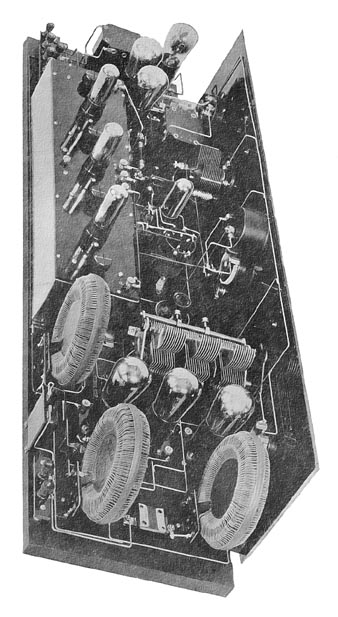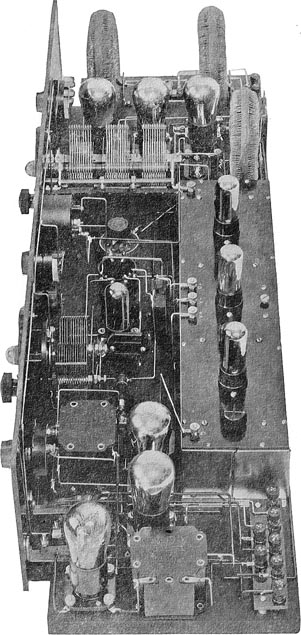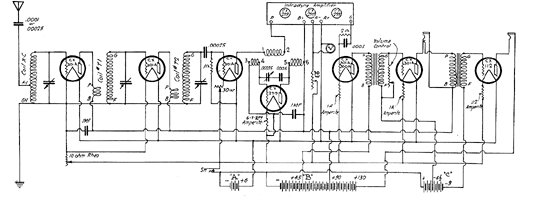The Infradyne Receiver
By Bruce McCalley
The Infradyne Receiver Introduced in the August 1926 issue of Radio, and was featured for several issues after that. The Infradyne was one of the more unusual designs of the early days of radio.


In the early days of radio there were a good number of odd-ball designs introduced. Some of these were to enable better performance, some were to save on the number of tubes required, and some seem to defy reason. The Infradyne, to this writer, seems to fit the last of these categories.
Designed by E. M. Sargent, the Infradyne was a superheterodyne receiver which featured an intermediate frequency (IF) of 3.2 Mhz instead of the more-or-less usual 50 Khz IF of the time. This high-frequency IF was created by using the sum of the incoming signal and the local oscillator frequencies instead of the difference between the two as in the usual superhet.
Why such a high frequency? The superheterodyne, invented by Edwin Armstrong, used a low frequency IF in order to achieve greater amplification using the triode tubes then available. Triodes tended to break into oscillation when used at high (radio) frequencies and until the use of neutralizing circuits, various methods were used to suppress this oscillation. Generally these methods were to introduce some loss in the circuit, either by means of a resistor in the grid circuit, or reducing the voltage supplied to the tube.


The Infradyne amplifier and schematic
Converting the incoming signal to a lower frequency enabled greater gain without the oscillation problem. Unfortunately, the low IF frequency made tuning difficult because if there were two signals just 100 Khz apart, both could beat with the local oscillator and generate the 50Khz IF frequency. Also, the IF frequency could be generated if the desired signal was above or below the oscillator frequency, making the station possibly appearing in two places on the dial. Modern receivers avoid these problems by using IF frequencies high enough that oscillator and incoming signals are widely separated.
Before the advent of screen-grid tubes, this higher frequency was not practical. The Infradyne, of course, defies this reasoning. Obviously with an IF of 3.2Mhz there would be no problems as described above with the superhet, but how do you obtain reasonable amplification with triodes at such a high frequency? This writer doesn't think they did!
The IF amplifier, called the "Infradyne Amplifier" used three '99 tubes on a separate chassis. It was manufactured by Remler, a division of Gray and Danielson Mfg. Co, San Francisco, California. It was intended to be inserted into the usual receiver circuit just ahead of the detector. The circuit of this amplifier is somewhat unusual (above). Note that the grid circuits are all tied together through the capacitor network yet they are "floating," that is, there is no return circuit to ground or other voltage. Strange, to say the least. This was not an error in the printed schematic. The accompanying text described the circuit, noting that there was enough residual leakage in the construction to adequately ground the grid circuits.

The Infradyne receiver schematic as designed by E.M. Sargent
Subsequent issues of Radio magazine described how the Infradyne amplifier might be added to existing radios. Many featured a switch to disconnect the amplifier, restoring the radio to its original design. Just why you would want to do this is an interesting question. My guess is that the radio probably worked better without the Infradyne amplifier. Issues of Radio magazine in the latter part of 1926 had advertisements of many manufacturers featuring their products as being suitable for the Infradyne. Other magazines of the period seemed to ignore the subject completely, or if mentioned, gave it little attention.
Several different designs of the complete Infradyne receiver were featured in Radio, but they were mainly the same circuit using a different layout and different components (other than the Infradyne amplifier). The Infradyne seemed to fade away in 1927. To this writer's knowledge the design never saw commercial production. It seems to have been a "wild idea" with little real merit.